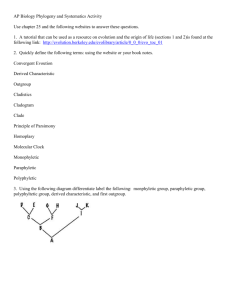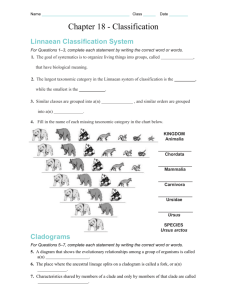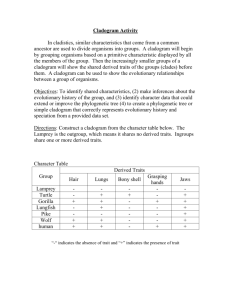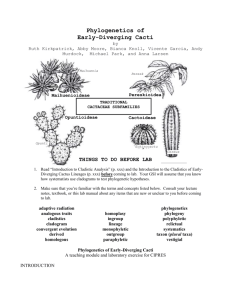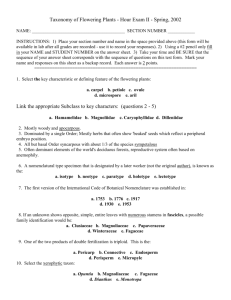Cactus Biogeography
advertisement
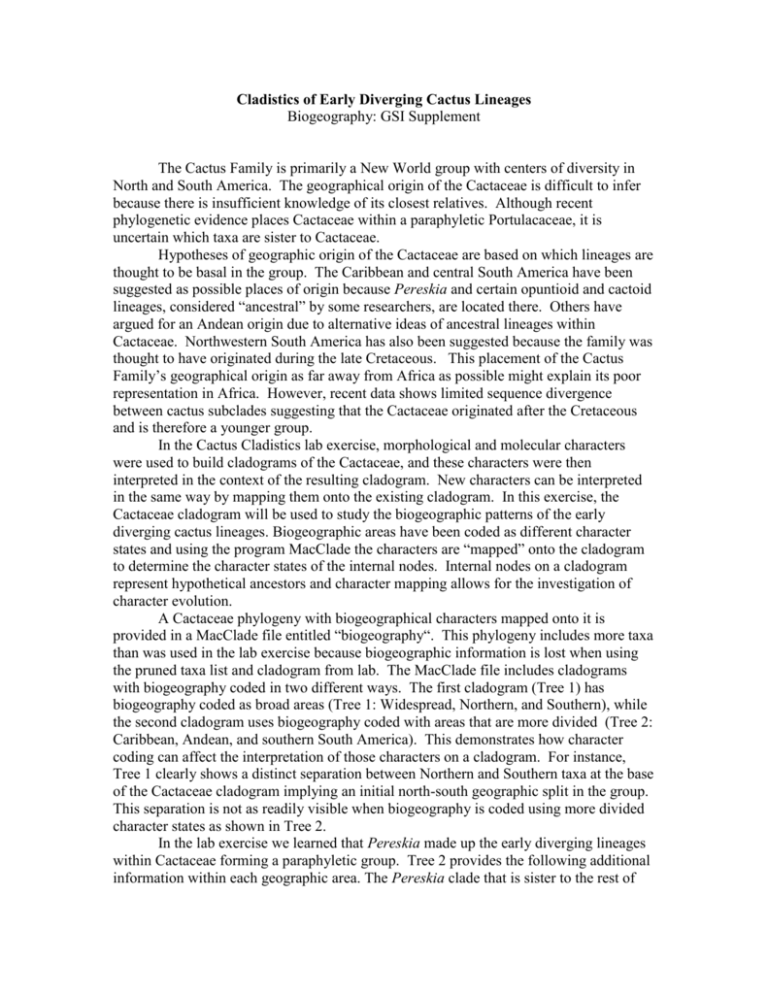
Cladistics of Early Diverging Cactus Lineages Biogeography: GSI Supplement The Cactus Family is primarily a New World group with centers of diversity in North and South America. The geographical origin of the Cactaceae is difficult to infer because there is insufficient knowledge of its closest relatives. Although recent phylogenetic evidence places Cactaceae within a paraphyletic Portulacaceae, it is uncertain which taxa are sister to Cactaceae. Hypotheses of geographic origin of the Cactaceae are based on which lineages are thought to be basal in the group. The Caribbean and central South America have been suggested as possible places of origin because Pereskia and certain opuntioid and cactoid lineages, considered “ancestral” by some researchers, are located there. Others have argued for an Andean origin due to alternative ideas of ancestral lineages within Cactaceae. Northwestern South America has also been suggested because the family was thought to have originated during the late Cretaceous. This placement of the Cactus Family’s geographical origin as far away from Africa as possible might explain its poor representation in Africa. However, recent data shows limited sequence divergence between cactus subclades suggesting that the Cactaceae originated after the Cretaceous and is therefore a younger group. In the Cactus Cladistics lab exercise, morphological and molecular characters were used to build cladograms of the Cactaceae, and these characters were then interpreted in the context of the resulting cladogram. New characters can be interpreted in the same way by mapping them onto the existing cladogram. In this exercise, the Cactaceae cladogram will be used to study the biogeographic patterns of the early diverging cactus lineages. Biogeographic areas have been coded as different character states and using the program MacClade the characters are “mapped” onto the cladogram to determine the character states of the internal nodes. Internal nodes on a cladogram represent hypothetical ancestors and character mapping allows for the investigation of character evolution. A Cactaceae phylogeny with biogeographical characters mapped onto it is provided in a MacClade file entitled “biogeography“. This phylogeny includes more taxa than was used in the lab exercise because biogeographic information is lost when using the pruned taxa list and cladogram from lab. The MacClade file includes cladograms with biogeography coded in two different ways. The first cladogram (Tree 1) has biogeography coded as broad areas (Tree 1: Widespread, Northern, and Southern), while the second cladogram uses biogeography coded with areas that are more divided (Tree 2: Caribbean, Andean, and southern South America). This demonstrates how character coding can affect the interpretation of those characters on a cladogram. For instance, Tree 1 clearly shows a distinct separation between Northern and Southern taxa at the base of the Cactaceae cladogram implying an initial north-south geographic split in the group. This separation is not as readily visible when biogeography is coded using more divided character states as shown in Tree 2. In the lab exercise we learned that Pereskia made up the early diverging lineages within Cactaceae forming a paraphyletic group. Tree 2 provides the following additional information within each geographic area. The Pereskia clade that is sister to the rest of the family consists of taxa found in northern South America, Central America, and the Caribbean (the Northern clade). Within the Northern clade, there is a Caribbean-centered group that contains P. bleo, P. quisqueyana, P. marcanoi, P. portulacifolia, and P. zinniiflora. Pereskia aureiflora is also a member of this clade but is found in southern Brazil and may represent a dispersal event to this region from the north. The remaining Pereskia taxa are found in southern South America (Southern clade). P. horrida, P. diazromeroana, and P. weberiana are found in the dry Inter-Andean valley regions of Peru and Bolivia (Andean clade). This clade is sister to P. aculeata, which is the only geographically widespread and ecologically diverse Pereskia species. Maihuenia is restricted to Chile and Argentina, and is sister to the Cactoideae. The cladogram (Tree 1) implies that both the Cactoideae and Opuntiodeae originated in the southern half of South America (Southern clade). This region’s geologic history suggests that the diversification of these groups likely occurred under a fluctuating arid/semi-arid climate regime during the early uplift in the central Andean region (~20-25 mya). The combination of climatic and geologic changes in this region has been viewed as the cause for the diversification of many plant groups. Movement northward to Mexico and the US occurred early within particular lineages (e.g. Cacteae represented by Echinocactus). Fig. 1: Cladogram with geography coded broadly. 1 = Cactoideae, 2 = Opuntiodeae. Fig. 2: Cladogram with more finely divided geographic areas added. 1 = Cactoideae, 2 = Opuntiodeae. Geographic distribution of basal cacti. Species ranges correspond to shaded area, except for the geographically widespread taxa: Pereskia aculeata (a circle), the Opuntioideae (a triangle), and all Cactoideae minus Blossfeldia (a triangle).

